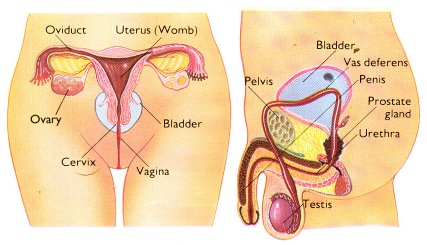 |
The reproductive system comprises all the organs which enable the process of reproduction to occur. The gonads (sex glands), the ovaries in females and testes in males, are the organs that produce the ova (egg cells) and spermatozoa. Accessory sexual organs allow these two cells to unite eventually in the process called fertilisation. The resulting zygote develops through embryonic and foetal stages until birth. |
Females
Ovaries: These are two small oval-shaped glands situated on either side of the upper part of the uterus (womb). They are situated right next to the fallopian tubes, which are extensions of the uterus that reach towards the ovaries, forming a sort of "T". Within the ovaries are tiny bodies called Graafian follicles. Each of these contain its own ovum, or egg. A number of them develop during each monthly cycle in response to the release of pituitary hormones (see The Brain), however only one of them is ever usually released.
Apart from the release of ova, the ovaries are responsible for the production of the female sex hormones, oestrogen and progesterone. These hormones are responsible for the female secondary sexual characteristics, including breast development, the differences in voice and body contour, and the production and distribution of pubic and body hair.
Fallopian tubes: As the ovum, or egg cell, is released from the surface of the ovary, it readily passes into the fallopian tubes, which are thin hollow structures which curl around the ovary at their outermost end. Fine hairs that line the surface of these tubes beat rhythmically to help the egg move towards the uterus. Fertilisation usually occurs in these tubes, and the zygote (fertilised ovum) is then transported towards the uterus where it will implant itself in the uterus wall.
Uterus: A muscular pear-shaped structure, this is where the implanted zygote develops until birth. The uterus lies at the top of the vagina, between the rectum behind, and the bladder in front. Its upper part is joined at its outer corners by the fallopian tubes. Its lower part narrows to form the cervix, which extends into the upper part of the vagina.
The lining of the uterus is called the endometrium. In preparation for possible acceptance of the zygote, this tissue enlarges in response to the ovarian hormone secretions. If fertilisation does not occur, the endometrium is shed in the menstrual flow.
Cervix: This has a central canal through which sperm pass, should intercourse take place. Except for during the menstrual flow, there is a plug of mucous present which protects the uterine cavity. About the time of ovulation, this mucous thins as a direct result of the high level of oestrogens.
Vagina: This is the internal female organ of intercourse. It is an expandable sheath which lies behind the lower part of the bladder and the rectum. Distension of the vagina is at its maximum during the birth process as the baby passes through it.
Males
Testes: The male testes are located within the thickened bag of skin called the scrotum. In their position beneath the penis, the testes are maintained about 1 degree Celsius below the average body temperature, this level being optimum for sperm production. Apart from the production of spermatozoa, the testes also secrete testosterone, the male sex hormone which is responsible for the secondary sexual characteristics. These include a deepening of the voice, growth of body and pubic hair, enlargement of the penis, and a more muscular physique.
Epididymis and vas deferens: Hundreds of very fine tubes called convoluted tubules lie within the substance of the testes. Sperm formed there are stored within the epididymis which lies behind each testis. The epididymis is a coiled tub-like structure which then continues and narrows to form the vas deferens.
Penis: The urethra conveys the ejaculate to the end of the penis, the male organ of intercourse. Layers of spongy erectile tissue lie within the shaft of the penis, and with stimulation it becomes erect as the spaces in the erectile tissue become filled with blood. During sexual intercourse, spermatozoa travel from the testes, through the urethra, and are deposited close to the cervix of the female, so they can enter the uterus. From 100 to over 500 million sperm are released during each ejaculation.